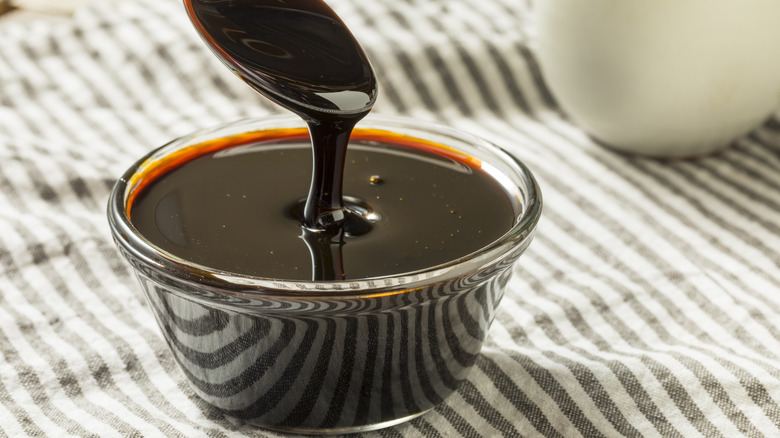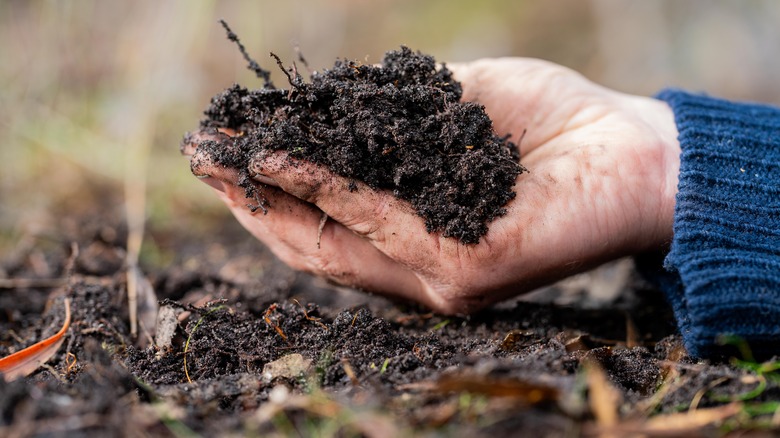The Potential Benefits Of Adding Blackstrap Molasses To Your Garden
We may receive a commission on purchases made from links.
When you picture molasses, you might remember tasting your first spoonful of the pungently sweet syrup or adding it carefully into a family cookie recipe, but molasses can also be surprisingly useful outside of the kitchen. Most molasses is made from sugar cane or sugar beet juice that has been boiled and reduced down to a syrup. Blackstrap molasses is the darkest, thickest version of molasses, produced by boiling the syrup three times. Blackstrap molasses has a deep, bitter flavor that some people may find intense and unappealing unless it's balanced well in a recipe, but the sticky stuff can actually provide a range of benefits for plants in your garden! Just a small amount of this powerful substance can support soil microbes, nourish your plants, and even protect your garden.
If you have a bottle of molasses that's been idling away on your shelf, let it bring new life to your garden! Blackstrap molasses contains vital nutrients that plants and microbes crave, but will also keep pests away from your precious produce. In fact, molasses could also be one of the best little-known tricks to eliminate anthills in your yard. Here's everything you need to know about the benefits of molasses and how you can use it around your yard and garden.
Blackstrap molasses is superfood for soil
Refined sugar is more or less nutritionally void, but blackstrap molasses is a surprisingly good source of manganese, magnesium, copper, selenium, calcium, iron, and potassium. These nutrients are commonly included in commercial fertilizers to support healthy plants and promote plant growth. In addition to feeding your plants, molasses is also a delicious sugary food source for microbes in the soil, such as azotobacter bacteria, which can help to enrich the soil and naturally add nitrogen for a healthier garden in no time. A study published in the Open Journal of Ecology found that blackstrap molasses, when combined with an organic fertilizer, led to a significant increase in microbe activity that lasted about four to five weeks. This high microbial activity improves soil structure, drainage, moisture retention, and aeration. In this way, blackstrap molasses works like an indirect fertilizer!
While molasses is great for plants and soil microbes, it's not so great for pests. Molasses sprayed on the leaves of plants will deter chewing pests like caterpillars, while molasses in the soil can protect against root knot nematodes. Horticultural dry molasses, which is made with a carrier grain and sprayed with liquid molasses, is also effective at repelling fire ants. Simple sugars in the molasses bloat the insects, killing them if they dare to take a nibble.
Choose unsulfured blackstrap and dilute before applying
What kind of molasses is best for use in the garden? Does it matter if the molasses is sulfured or unsulfured? As the name might suggest, sulfured molasses has been treated with sulfur dioxide to keep the sweet product from spoiling and becoming unsafe to eat. While plants do appreciate some sulfur, adding too much can affect the pH of your soil, so it's best to opt for organic, unsulfured blackstrap molasses. You can also purchase blackstrap molasses designed specifically for garden use, such as Nature's Wisdom horticultural molasses, available on Amazon for just under $32 per gallon. For easier application, try a dry molasses like this one by GARDENWISE on Amazon, which can either be mixed with water or sprinkled over soil.
If you want to use the leftover molasses in your kitchen, the easiest way to apply it in your garden is to mix it with water and spray or pour the mixture over the soil. Dilute the molasses by adding about two tablespoons into every gallon of water. Alternatively, you can mix the molasses in with an organic fertilizer before or use it to amend store-bought soil to improve the life of your plants. Pour the molasses over pre-watered soil to ensure good absorption, and apply the molasses to your garden no more than once every two weeks to avoid throwing off the soil pH or overdoing it with the sugars.


